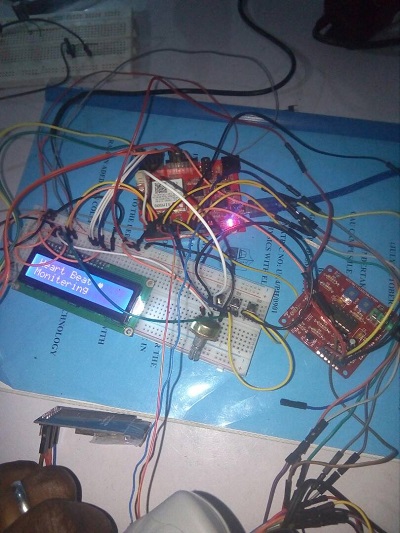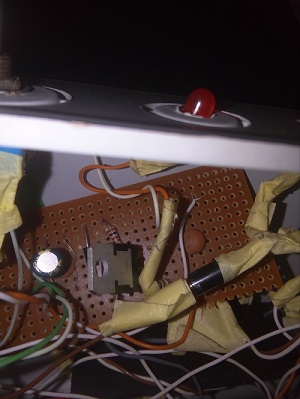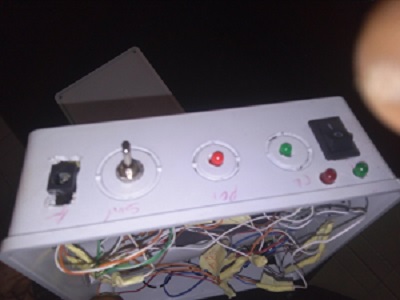Development of A Patient Pill Scheduled Reminder And Monitoring Device #1.
My Story
This work is actually an inspiration from my friend, a Medical Doctor who perpetually complain about his patient who does skip his medications. I got interested in the case and begin to think about how to help the man. I realised from my short interaction with the 70 years old patient, that he usually forget to take his medication and the skip was not intentional. So I got to know that the man needed a reminder and monitoring device to achieve full medication compliance.
Let get started
Introduction
This article shall describe a system that uses a Radio Frequency Identification (RFID) technology and a scale to tracks a patient’s medicine supply. When a patient received a new medicine, the system allows a patient to assigns a uniquely identifiable RFID tag to its container and also inputs the corresponding schedule information into the system. The Real-Time Clock (RTC) to be incorporated in the medicine storage device can notify the patient when a particular medicine is to be taken. The scale is used to check if the patient actually takes the medicine by comparing the weight of drugs and container before and after each scheduled time.
The system also succeeds in providing an audible reminder to forgetful patients using an incorporated alarm system. The alarm system makes a continuous beeping until the patient dispense the actual drug while the scaling system makes a logical comparison between initial and final drug weight. To ascertain the faithful dispense of drugs by the patient, the alarm system continues to beep loudly if the scaling outcome is logically incorrect (a situation whereby the patient failed to dispense the correct number of pills). This can dispense individual medications and alert a patient’s caregiver if medicine dosages are not taken correctly. The feedback system of the device made use of a GSM module compatible with a 2G SIM, it works perfectly with a regulated 5volts, 2 Ampere power supply.

Image showing a device prototyping
The GSM based feedback system actually works to notify a patient’s caregiver about patient compliance to correct and timely medication by sending SMS to a registered phone number of a doctor or a patient’s caregiver. In a scenario whereby a patient failed to correctly dispense the right drug at the right time or the patient failed to dispense drug at all, the alarm system continues to beep for ten minutes and after ten minutes of beep without a needful response from the patient, the feedback system is being triggered to send SMS to the caregiver. SMS such as “Pill Dispense Error, if the patient failed to dispense pill, Incorrect Dispense, if the patient failed to dispense the right dosage or Container Empty if the pill is exhausted”.
Without these features, the most critical interactions with the system would likely have to be done by an able caregiver. As an alternative to manual entry, the system described in this article relies on prescription schedule information encoded on an RFID tag and attached at the patient’s pharmacy. This enhances the ability of the patient to simply configure the device by placing the new medicine container on the device. Eliminating the need for the patient to manually choose the correct medicine to take, the system implements the ability to dispense individual medicine containers using a novel motorized storage tray. And finally, patient compliance can be monitored by the caregiver from a remote location using a cellphone. The implementation of the user-friendly design, allow the revised system to be used by patients while living independently, totally eliminating the ever-presence and stress encountered by caregivers.

Image showing device hardware implementation
Conversely, this project bridge gaps of previous works and literature that have provided information and practical means of in-home medication monitoring and notification using contemporary technology. The first part of this article shall describe the background and research literature review of theory and practical specifications needed for design and implementation of the described system. The second part shall describe the prototyped implementation of the revised system. The final part shall describe device performance evaluation and testing.
This project aims at the design and construction of Radio Frequency Identification (RFID) pill schedule reminder system. The above-mentioned aim could be achieved through the following objectives: To develop a system that allows healthcare patients to comply with complex medication regimens without the active assistance of a caregiver, to prototype a device that is built to implement the system designed in such a way that it is marketable to anyone who takes medicine on a regular predefined schedule, and to publish all hardware and software design components associated with the device, including source code so that the device can be reproduced and further development can be done.
Design Consideration
To achieve a device design and construction capable of administering medications in a way similar to a live caregiver, allowing a patient to add, remove, and access medications using only the assistance of the device, while effectively allowing healthcare patients to maximize a reasonable length of time independently without much interference by a caregiver, the following requirements are to be considered during device design and implementation; Pharmacy Integration, Intuitive User Interface, Dosage Intake Monitoring, Medicine Container Distinction, Unexpected Input Handling, Dynamic Dosage Scheduling, Remote Care, and Direct Communication with Caregiver.
Pharmacy integration has to do with a design which ensures that medicine schedule information is stored on each medicine container’s RFID tag. This is to ensure that the information is loaded automatically and accurately, which eliminate the user or caregiver to enter medicine schedule information into the system manually and the risk of error associated with human input. Moreover, the device design maintains users’ behaviour similar to the way the patient normally manages medications. The incorporated Intuitive User Interface is important because a behavioural change to high-tech devices especially in elderly people might seem to be difficult. Changing the usual behaviour from using a medicine cabinet to a high-tech device could be very intimidating to some user who has never used a computer before.

Image showing part of the finished work
Since the medicine containers are stored together, it is necessary to consider a device capable of distinguishing pill containers and able to identify which container to dispense drug at a particular point in time. This parameter must be accurately and correctly implemented, any failure in this regard could cause patients improper drug intake which might eventually cause more harm and complications. Medicine container distinction can be easily implemented using Radio Frequency Identification (RFID) with a uniquely identifiable RFID tag to containers. These uniquely identifiable RFIDs are used within lines of codes to call for needed pill container when it’s time to dispense such pill. Also, the device shall be able to monitor patient dose intake using initial and final scale measurement values comparison.
The device was designed to directly communicate a patient’s caregiver in case of noncompliance by incorporating a GSM module to the device. The GSM module works perfectly on 2G network, capable to send SMS to a registered phone number of a caregiver in case of noncompliance or system failure. This feature serves as a feedback system which made it easy to monitor a patient even when the caregiver is far away (remote care).
The next episode shall discuss the hardware and software implementation of this work.
Thanks for reading.
References
Ken Fishkin and Min Wang, "A Flexible, Low-Overhead Ubiquitous System for Medication Monitoring," Seattle, WA, 2003.
Melody Moh, Loc Ho, Zachary Walker, and Teng-Sheng Moh, "A Prototype on RFID and Sensor Networks for Elderly Health Care," in RFID Handbook: Applications, Technology, Security, and Privacy, 1st ed., Syed Ahson and Mohammad Ilyas, Eds. Boca Raton, FL, 2008, pp. 311-328.
National Council on Patient Information and Education, "Enhancing Prescription Medicine Adherence: A National Action Plan," 2007.
Eric Ishman, "Inventing Wellness Systems for Aging in Place," IEEE Computer, pp. 34-41, May 2004.
Upkar Varshney, "Pervasive Healthcare and Wireless Health Monitoring," Mobile Networks and Applications, vol. 12, pp. 113-127, 2007.
Alison M. Kenner, "Securing the Elderly Body: Dementia, Surveillance, and the Politics of "Aging in Place"," Surveillance & Society, vol. 5, no. 3, pp. 252-269, 2008.
Juan M. Corchado, Javier Bajo, Yanira De Paz, and Dante I. Tapia, "Intelligent Environment for Monitoring Alzheimer Patients Agent Technology for Health Care," Decision Support Systems, vol. 44, no. 2, pp. 382-396, 2008.
Corey McCall. (2010, July) Personal Medication Monitor v0.9 Source Code.
[Online]. http://cns.eecs.ucf.edu/PMM/download/McCall_PMM_v09.pde
Olga Boric-Lubecke and Victor M. Lubecke, "Wireless House Calls: Using Communications Technology for Health Care and Monitoring," IEEE Microwave , pp. 43-48, September 2002.
Pei R. Sun, Bo H. Wang, and Fan Wu, "A New Method to Guard Inpatient Medication Safety by the Implementation of RFID," Journal of Medical Systems, vol. 32, pp. 327-332, 2008.
Thanks for your contribution to the STEMsocial community. Feel free to join us on discord to get to know the rest of us!
Please consider supporting our funding proposal, approving our witness (@stem.witness) or delegating to the @stemsocial account (for some ROI).
Please consider using the STEMsocial app app and including @stemsocial as a beneficiary to get a stronger support.